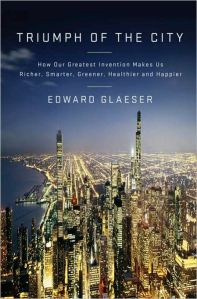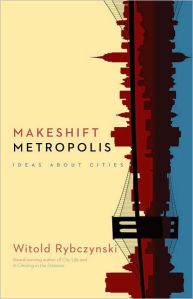People or Place in Urban Planning?
 In his deservedly well-reviewed book Triumph of the City the Harvard economist Edward Glaeser unambiguously opts for people as the key element that determines a city’s success. He argues that a place-centered approach to urban planning—that is, one informed by a “build it and they will come” logic that uses convention centers, pedestrian malls, festival marketplaces, light rail systems, and iconic buildings to reinvigorate downtowns—may have been “the biggest mistake in urban policy of the last 60 years.” Put differently, place-centered planning is a prime example of “edifice error.” Detroit serves as the textbook example of such folly, as evidenced by the failure of the GM Renaissance Center and the People Mover monorail to enliven the urban core.
In his deservedly well-reviewed book Triumph of the City the Harvard economist Edward Glaeser unambiguously opts for people as the key element that determines a city’s success. He argues that a place-centered approach to urban planning—that is, one informed by a “build it and they will come” logic that uses convention centers, pedestrian malls, festival marketplaces, light rail systems, and iconic buildings to reinvigorate downtowns—may have been “the biggest mistake in urban policy of the last 60 years.” Put differently, place-centered planning is a prime example of “edifice error.” Detroit serves as the textbook example of such folly, as evidenced by the failure of the GM Renaissance Center and the People Mover monorail to enliven the urban core.
Instead, Glaeser argues for planning strategies that invest in people: small businesses, affordable housing, and education. He does see a role for infrastructure in supporting people-centered strategies, especially the high-rise residential skyscraper. Building up is perfect for creating the sort of population density that fosters human collaboration and creativity, while also having certain “green” virtues. However, efforts to create vertical density are, in Glaeser’s view, too often foiled by other place-centrisms like historic preservation. Too many historical landmark and district designations inhibit commercial development and severely limit the supply of affordable housing that would draw a mix of people back to the city. Preservation can too easily turn urban cores into museums accessible only to well-heeled tourists and the very rich. Paris, for all its aesthetic beauty, serves as Glaeser’s prime cautionary tale in this regard.
 The other great book about the city to appear in the last year—Makeshift Metropolis by Witold Rybczynski, a Professor of Urbanism at the University of Pennsylvania—is a bit more appreciative of place-centered urban planning. Several American cities including San Francisco, Boston, San Antonio, and Baltimore have capitalized on their distinctive locations and histories by combining “nostalgia” with innovative design to produce vibrant downtown centers. In each case the effort was helped by the proximity of water, a love of which is arguably hard-wired into the psyche of human beings (see “Evolution’s City”, below). Rybczynski, like Glaeser, notes that iconic architecture has helped spur economic development in some cities—Gehry’s Guggenheim Museum in Bilbao, Spain is everyone’s favorite example—but has been less successful in far too many others. These include Denver, where Daniel Libeskind’s new wing of the city’s art museum hasn’t generated the anticipated number of visitors or dollars. Rybczynski concludes that the widely invoked and analyzed Bilbao “Effect” is more of an “Anomaly,” and that cities should expect only modest success when using the iconic building as a means to urban renewal.
The other great book about the city to appear in the last year—Makeshift Metropolis by Witold Rybczynski, a Professor of Urbanism at the University of Pennsylvania—is a bit more appreciative of place-centered urban planning. Several American cities including San Francisco, Boston, San Antonio, and Baltimore have capitalized on their distinctive locations and histories by combining “nostalgia” with innovative design to produce vibrant downtown centers. In each case the effort was helped by the proximity of water, a love of which is arguably hard-wired into the psyche of human beings (see “Evolution’s City”, below). Rybczynski, like Glaeser, notes that iconic architecture has helped spur economic development in some cities—Gehry’s Guggenheim Museum in Bilbao, Spain is everyone’s favorite example—but has been less successful in far too many others. These include Denver, where Daniel Libeskind’s new wing of the city’s art museum hasn’t generated the anticipated number of visitors or dollars. Rybczynski concludes that the widely invoked and analyzed Bilbao “Effect” is more of an “Anomaly,” and that cities should expect only modest success when using the iconic building as a means to urban renewal.
No anthropologist would dispute that, at the end of the day, the success of a human settlement of any kind depends upon people. But they would never marginalize the role of the built environment in producing civic success. A robust body of theory and cross-cultural empirical research in the area of human “materiality” has established that people and things are co-dependent. Material objects are crucial to stabilizing individual psychology, regulating social relationships, and transmitting cultural meaning. The built environment is particularly important in transforming generic space into a lived place with which people can identify and to which they can commit. James Brooks, writing about Glaeser’s book in the National League of Cities blog, pretty much nails the anthropological view:
Certainly the factor of human collaboration is the powerful value of the city. Ideas and energy swirl among people in a dense urban space fostering miracles of insight and innovation…But skills and creativity are portable. The talented are footloose. Therefore, what qualities of urban life bind creative and talented people to a particular place? Assuming it’s relatively simple to learn what people want, the next logical question for policy makers is to ask how do you build, rebuild or improve one particular place in order to hang on to the talented people? Put another way, how do you build and sustain a community that people want to remain in rather than drive through? No two things on earth are exactly equal. Not people, nor plants, nor sunsets nor least of all cities. The city as an institution may have several features that transfer across time and place, but the individual cities themselves are as unique as snowflakes. In that uniqueness lies the power of place [emphasis in original].
Interestingly, Rybczynski also understands that a good urban planning project must “quickly establish that elusive quality, a sense of place [emphasis in the original].” And, he understands that drawing on local context and history is important in creating that sense of place. Today’s challenge to urban architects, planners and developers is to keep both in mind; to attend to both historical and environmental context in creating not icons but rather settings akin to those that we admire in Paris, London, and other great world cities. Such sensitivity is still in short supply in Denver and may explain why the official selection of Santiago Calatrava’s aesthetically pleasing and iconic bird-winged design for a new Denver International Airport terminal–a choice seemingly intended to signal Denver’s arrival as a global city if not an emerging aerotropolis–did not, for many locals, measure up to Curtis Fentress’s original terminal evoking (depending on your nostalgic sensibilities) either the Rocky Mountains or a Plains Indian teepee village.
In short, “People or Place?” is the wrong question, and an unhelpful dichotomy. A high density of people alone is not likely to produce the requisite social capital for generating a successful city. Indeed, recent research suggests that social capital can also be produced by walkable neighborhoods. In either case, as Brooks suggests, you still have to find ways to materially “bind” people to place. To give materiality its due is not to embrace a crude architectural determinism, something that Ken Archer worries about in a very provocative piece on Big Tent Urbanism (in which he also expresses a preference for people-centered development). Rather, it’s to embrace a theory of people-place co-dependence. An intercultural perspective on place and built environment that’s informed by a deeper understanding of the great cosmopolitan cities of past and present offers one guide for such a project.


Leave a Reply